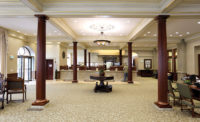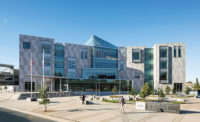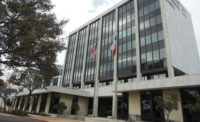Granite City of Eagle River, AK, was founded 11 years ago by current president, Matt Hickey, and vice president/general manager, Barry Anderson. They remain the owners today, along with treasurer, Melissa Hickey. Matt Hickey and Anderson had been working in the construction field for 40 years. They partnered to start the business because they saw a need for a granite fabrication and installation shop in the area.
The company operates a 10,000-square-foot facility, which was remodeled entirely to fit their needs. They manufacture a variety of brands of quartz, as well as natural granite, which is typically used for countertops. They aim to cut and fabricate four to six slabs in an eight-hour shift.
The team consists of 20 employees, including four in the office and 16 on the shop/installation side. In addition, Granite City runs two installation trucks — each with one installer and one helper. “We will usually send four to six guys out to carry a job in, and then the installer and his helper will stay to do the finishing touches and the carry-in crew will return to the shop to fab for the next day,” explained Justin Nelson, production manager at Granite City. “We run one shift that starts between 7 a.m. and 8 a.m., depending on the daily load and ends typically around 5 p.m.”
The business, which focuses mainly on residential projects, and targets all of (accessible) Alaska as its primary market, fabricates and installs anywhere from 10 to 20 kitchens in a week. “Most of our jobs are around 65 square feet, although it seems we have had a run of some monsters during this year’s holiday rush that have been as big as 200 square feet,” said Nelson. “These have included bath tub decks, kitchens, laundry rooms and fireplaces — basically everything in the house you could put granite on we did.”
The fabrication operation
Granite City’s fabrication shop houses a Yukon II bridge saw for cutting and a Titan CNC stoneworking center for any special edge work, as well as for cutting and polishing sink holes — both from Park Industries of St. Cloud, MN. “We added the Titan in the summer of 2015, which has drastically improved production time,” said Nelson. “We went from one to one-and-a-half hours to cut and polish a sink to 30 minutes. When it comes to edge work, such as an ogee, the Titan can blast out the edge work and polishing in a fraction of the time it used to take us, which has allowed us to put more guys in the field installing and less in the shop fabricating.”
Many brands of tools and accessories are also used in the production process. Among the lineup is a Manzelli vacuum lifter, an Abaco pincher, Zenesis diamond blades, Diamut and Tyrolit CNC tooling, suctions pods from Blick Industries, Barranca Diamond polishers, skill saws and polishing pads from Alpha Professional Tools, Copper Head polishing pads, Cyclone 3-step polishing pads from Diamax, Integra Adhesives, Diamond Wright sink clippers, sink clippers and sink bars from Omni Cubed, Seam Setter seamers, Aardwolf carrying clamps, transport A-frames from Groves Inc., a Marmoelettromeccanica router, and Rival diamond blades and core bits. The company primarily buys its tools from Granite City Tool and a few of the local hardware stores. For templating, Granite City uses a 1/8-inch tempered hard board and white corrugated plastic to make hard templates in the field. “We digitize them in the shop only if they have an edge other than eased, as we get a better finish faster by hand on eased edges,” explained Nelson. “For digital templating, we use the Prodim Proliner 8 and a Laser Products LT-2D3D. We bought the Proliner in 2015 out of necessity so we could digitize our templates for use on the CNC, which has saved us lots of time on custom shapes, wall scribes and sink cut outs. Also, I felt it would be better at drawing sinks and difficult scribes than a laser. There was a little bit of a learning curve as far as what each button is used for and trying to remember it. Overall, we have been very successful from day one using it. I can’t recall any mistakes that have been made while using it with no training other than reading the manual.”
As all companies encounter, there are always challenges and obstacles that need to be met.
For Nelson and his team, the biggest difficulty is finding and keeping quality talent. “In any construction field, it’s always hard to find and train hard-working employees who have pride in their work,” he said.
As for the future, Nelson is thinking large scale. “Short-term, we want to add a CNC saw of some sort to really speed up production,” he said. “Long-term, we are working towards becoming the largest and best granite and quartz stockyard in Alaska.”
Granite City- Eagle River, AKType of work: residential Machinery:
Number of Employees: 20 Production Rate: 10 to 20 kitchens per week — measuring 65 square feet on average |













